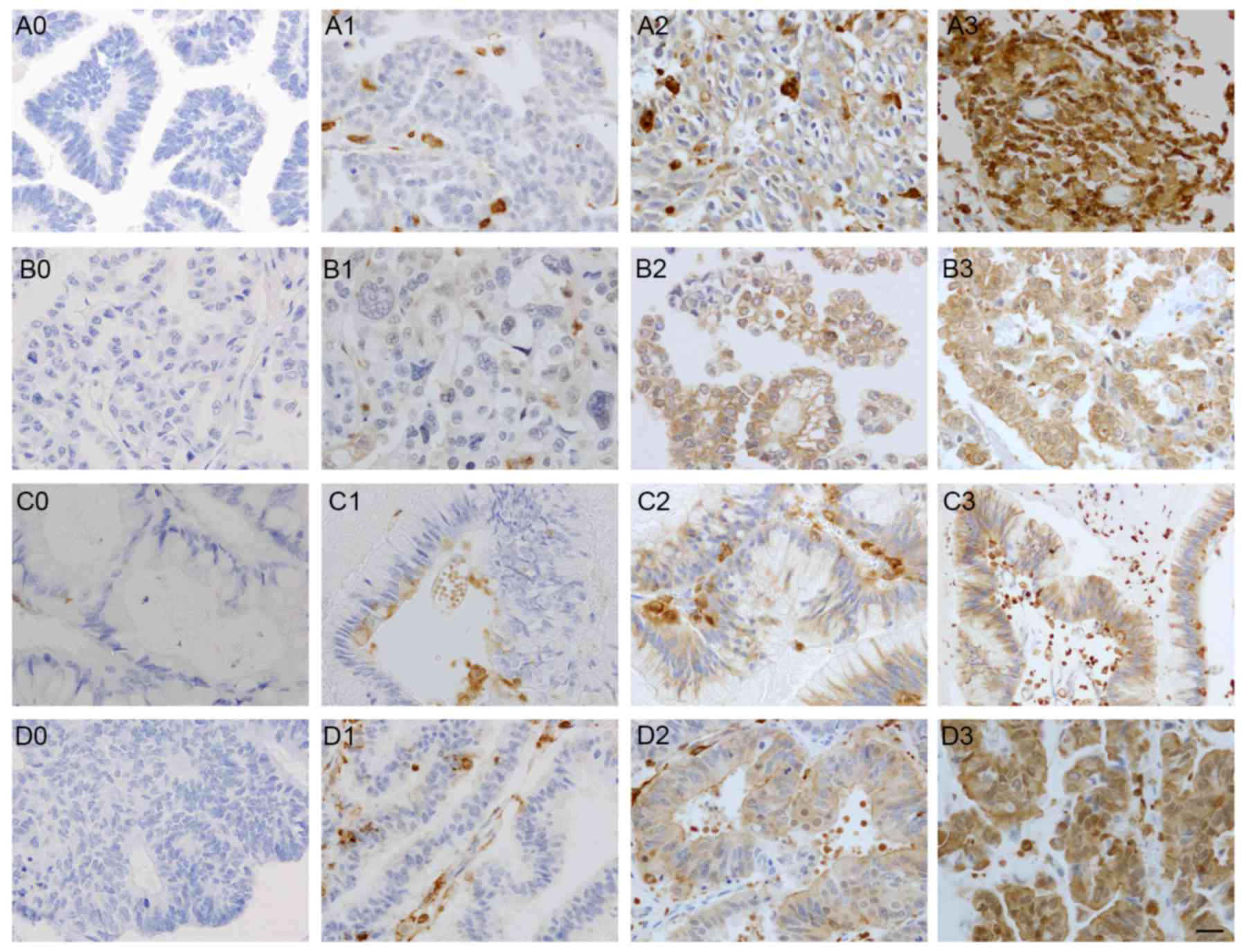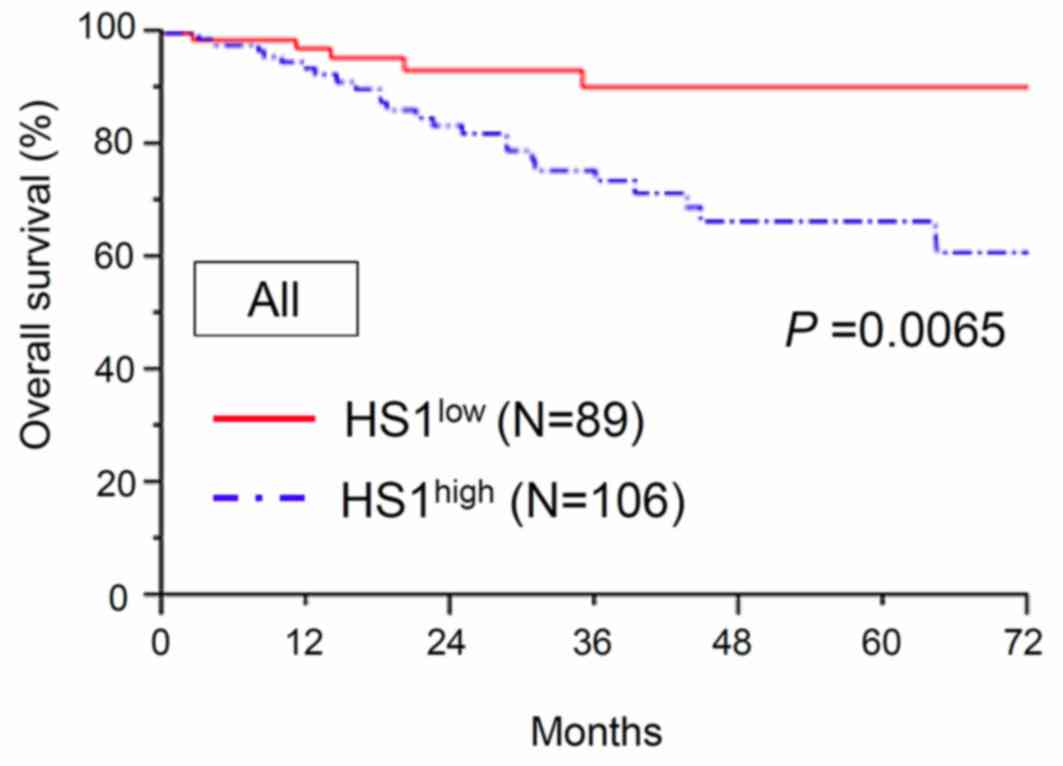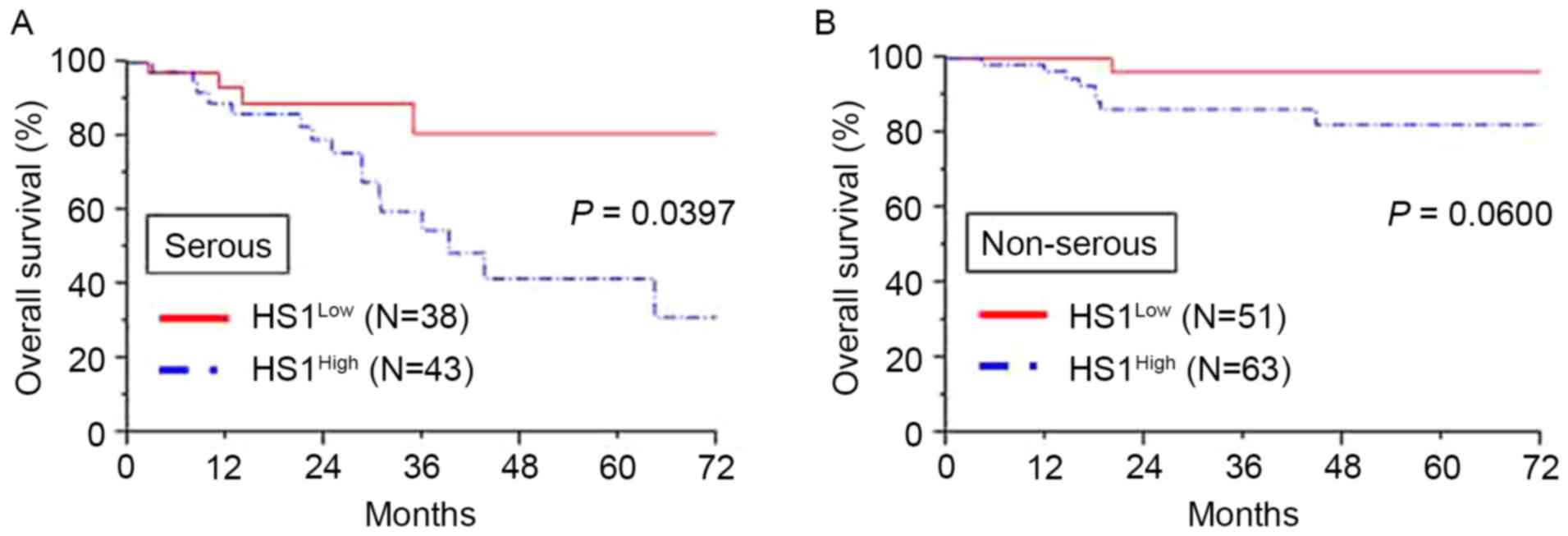|
1
|
Siegel RL, Miller KD and Jemal A: Cancer
statistics, 2015. CA Cancer J Clin. 65:5–29. 2015. View Article : Google Scholar : PubMed/NCBI
|
|
2
|
Kajiyama H, Shibata K, Mizuno M, Umezu T,
Suzuki S, Yamamoto E, Fujiwara S, Kawai M, Nagasaka T and Kikkawa
F: Long-term clinical outcome of patients with recurrent epithelial
ovarian carcinoma: Is it the same for each histological type? Int J
Gynecol Cancer. 22:394–399. 2012. View Article : Google Scholar : PubMed/NCBI
|
|
3
|
Kikkawa F, Nawa A, Ino K, Shibata K,
Kajiyama H and Nomura S: Advances in treatment of epithelial
ovarian cancer. Nagoya J Med Sci. 68:19–26. 2006.PubMed/NCBI
|
|
4
|
Yoshikawa N, Kajiyama H, Mizuno M, Shibata
K, Kawai M, Nagasaka T and Kikkawa F: Clinicopathologic features of
epithelial ovarian carcinoma in younger vs. older patients:
Analysis in Japanese women. J Gynecol Oncol. 25:118–123. 2014.
View Article : Google Scholar : PubMed/NCBI
|
|
5
|
Eisenkop SM, Friedman RL and Wang HJ:
Complete cytoreductive surgery is feasible and maximizes survival
in patients with advanced epithelial ovarian cancer: A prospective
study. Gynecol Oncol. 69:103–108. 1998. View Article : Google Scholar : PubMed/NCBI
|
|
6
|
Kitamura D, Kaneko H, Miyagoe Y, Ariyasu T
and Watanabe T: Isolation and characterization of a novel human
gene expressed specifically in the cells of hematopoietic lineage.
Nucleic Acids Res. 17:9367–9379. 1989.PubMed/NCBI
|
|
7
|
Kitamura D, Kaneko H, Taniuchi I, Akagi K,
Yamamura K and Watanabe T: Molecular cloning and characterization
of mouse HS1. Biochem Biophys Res Commun. 208:1137–1146. 1995.
View Article : Google Scholar : PubMed/NCBI
|
|
8
|
Scielzo C, Bertilaccio MT, Simonetti G,
Dagklis A, Ten Hacken E, Fazi C, Muzio M, Caiolfa V, Kitamura D,
Restuccia U, et al: HS1 has a central role in the trafficking and
homing of leukemic B cells. Blood. 116:3537–3546. 2010. View Article : Google Scholar : PubMed/NCBI
|
|
9
|
Yamamoto T, Yamanashi Y and Toyoshima K:
Association of Src-family kinase Lyn with B-cell antigen receptor.
Immunol Rev. 132:187–206. 1993. View Article : Google Scholar : PubMed/NCBI
|
|
10
|
Yamanashi Y, Okada M, Semba T, Yamori T,
Umemori H, Tsunasawa S, Toyoshima K, Kitamura D, Watanabe T and
Yamamoto T: Identification of HS1 protein as a major substrate of
protein-tyrosine kinase(s) upon B-cell antigen receptor-mediated
signaling. Proc Natl Acad Sci USA. 90:3631–3635. 1993. View Article : Google Scholar : PubMed/NCBI
|
|
11
|
Dehring DA, Clarke F, Ricart BG, Huang Y,
Gomez TS, Williamson EK, Hammer DA, Billadeau DD, Argon Y and
Burkhardt JK: Hematopoietic lineage cell-specific protein 1
functions in concert with the Wiskott-Aldrich syndrome protein to
promote podosome array organization and chemotaxis in dendritic
cells. J Immunol. 186:4805–4818. 2011. View Article : Google Scholar : PubMed/NCBI
|
|
12
|
Butler B, Kastendieck DH and Cooper JA:
Differently phosphorylated forms of the cortactin homolog HS1
mediate distinct functions in natural killer cells. Nat Immunol.
9:887–897. 2008. View
Article : Google Scholar : PubMed/NCBI
|
|
13
|
Caligaris-Cappio F, Bergui L, Tesio L,
Corbascio G, Tousco F and Marchisio PC: Cytoskeleton organization
is aberrantly rearranged in the cells of B chronic lymphocytic
leukemia and hairy cell leukemia. Blood. 67:233–239.
1986.PubMed/NCBI
|
|
14
|
Thomas SG, Calaminus SD, Auger JM, Watson
SP and Machesky LM: Studies on the actin-binding protein HS1 in
platelets. BMC Cell Biol. 8:462007. View Article : Google Scholar : PubMed/NCBI
|
|
15
|
Hussein K, von Neuhoff N, Büsche G, Buhr
T, Kreipe H and Bock O: Opposite expression pattern of Src kinase
Lyn in acute and chronic haematological malignancies. Ann Hematol.
88:1059–1067. 2009. View Article : Google Scholar : PubMed/NCBI
|
|
16
|
Scielzo C, Ghia P, Conti A, Bachi A, Guida
G, Geuna M, Alessio M and Caligaris-Cappio F: HS1 protein is
differentially expressed in chronic lymphocytic leukemia patient
subsets with good or poor prognoses. J Clin Invest. 115:1644–1650.
2005. View
Article : Google Scholar : PubMed/NCBI
|
|
17
|
Hao JJ, Zhu J, Zhou K, Smith N and Zhan X:
The coiled-coil domain is required for HS1 to bind to F-actin and
activate Arp2/3 complex. J Biol Chem. 280:37988–37994. 2005.
View Article : Google Scholar : PubMed/NCBI
|
|
18
|
He H: HS1 and EMS1. Gan To Kagaku Ryoho.
24:1448–1453. 1997.(In Japanese). PubMed/NCBI
|
|
19
|
van Rossum AG, Schuuring-Scholtes E, van
Buuren-van Seggelen V, Kluin PM and Schuuring E: Comparative genome
analysis of cortactin and HS1: The significance of the F-actin
binding repeat domain. BMC Genomics. 6:152005. View Article : Google Scholar : PubMed/NCBI
|
|
20
|
Schuuring E, van Damme H,
Schuuring-Scholtes E, Verhoeven E, Michalides R, Geelen E, de Boer
C, Brok H, van Buuren V and Kluin P: Characterization of the EMS1
gene and its product, human Cortactin. Cell Adhes Commun.
6:185–209. 1998. View Article : Google Scholar : PubMed/NCBI
|
|
21
|
Zhao G, Huang ZM, Kong YL, Wen DQ, Li Y,
Ren L and Zhang HY: Cortactin is a sensitive biomarker relative to
the poor prognosis of human hepatocellular carcinoma. World J Surg
Oncol. 11:742013. View Article : Google Scholar : PubMed/NCBI
|
|
22
|
Ambrosio EP, Rosa FE, Domingues MA,
Villacis RA, Coudry Rde A, Tagliarini JV, Soares FA, Kowalski LP
and Rogatto SR: Cortactin is associated with perineural invasion in
the deep invasive front area of laryngeal carcinomas. Hum Pathol.
42:1221–1229. 2011. View Article : Google Scholar : PubMed/NCBI
|
|
23
|
Lin CK, Chao TK, Yu CP, Yu MH and Jin JS:
The expression of six biomarkers in the four most common ovarian
cancers: Correlation with clinicopathological parameters. APMIS.
117:162–175. 2009. View Article : Google Scholar : PubMed/NCBI
|
|
24
|
Ni QF, Yu JW, Qian F, Sun NZ, Xiao JJ and
Zhu JW: Cortactin promotes colon cancer progression by regulating
ERK pathway. Int J Oncol. 47:1034–1042. 2015. View Article : Google Scholar : PubMed/NCBI
|
|
25
|
Noh SJ, Baek HA, Park HS, Jang KY, Moon
WS, Kang MJ, Lee DG, Kim MH, Lee JH and Chung MJ: Expression of
SIRT1 and cortactin is associated with progression of non-small
cell lung cancer. Pathol Res Pract. 209:365–370. 2013. View Article : Google Scholar : PubMed/NCBI
|
|
26
|
Tavassoli FA and Devilee Peter: Pathology
and genetics of tumours of the breast and female genital organs.
Lyon: IAPS Press, 2003; 2003
|
|
27
|
Heintz AP, Odicino F, Maisonneuve P,
Beller U, Benedet JL, Creasman WT, Ngan HY, Sideri M and Pecorelli
S: Carcinoma of the ovary. J Epidemiol Biostat. 6:107–138.
2001.PubMed/NCBI
|
|
28
|
Miglarese MR, Mannion-Henderson J, Wu H,
Parsons JT and Bender TP: The protein tyrosine kinase substrate
cortactin is differentially expressed in murine B lymphoid tumors.
Oncogene. 9:1989–1997. 1994.PubMed/NCBI
|
|
29
|
Zhan X, Haudenschild CC, Ni Y, Smith E and
Huang C: Upregulation of cortactin expression during the maturation
of megakaryocytes. Blood. 89:457–464. 1997.PubMed/NCBI
|
|
30
|
Mizutani K, Miki H, He H, Maruta H and
Takenawa T: Essential role of neural Wiskott-Aldrich syndrome
protein in podosome formation and degradation of extracellular
matrix in src-transformed fibroblasts. Cancer Res. 62:669–674.
2002.PubMed/NCBI
|
|
31
|
Schuuring E, Verhoeven E, Litvinov S and
Michalides RJ: The product of the EMS1 gene, amplified and
overexpressed in human carcinomas, is homologous to a v-src
substrate and is located in cell-substratum contact sites. Mol Cell
Biol. 13:2891–2898. 1993. View Article : Google Scholar : PubMed/NCBI
|
|
32
|
Gattazzo C, Martini V, Frezzato F,
Trimarco V, Tibaldi E, Castelli M, Facco M, Zonta F, Brunati AM,
Zambello R, et al: Cortactin, another player in the Lyn signaling
pathway, is over-expressed and alternatively spliced in leukemic
cells from patients with B-cell chronic lymphocytic leukemia.
Haematologica. 99:1069–1077. 2014. View Article : Google Scholar : PubMed/NCBI
|
|
33
|
Xu XZ, Garcia MV, Li TY, Khor LY,
Gajapathy RS, Spittle C, Weed S, Lessin SR and Wu H: Cytoskeleton
alterations in melanoma: Aberrant expression of cortactin, an
actin-binding adapter protein, correlates with melanocytic tumor
progression. Mod Pathol. 23:187–196. 2010. View Article : Google Scholar : PubMed/NCBI
|
|
34
|
Soslow RA: Histologic subtypes of ovarian
carcinoma: An overview. Int J Gynecol Pathol. 27:161–174.
2008.PubMed/NCBI
|
|
35
|
Taniuchi I, Kitamura D, Maekawa Y, Fukuda
T, Kishi H and Watanabe T: Antigen-receptor induced clonal
expansion and deletion of lymphocytes are impaired in mice lacking
HS1 protein, a substrate of the antigen-receptor-coupled tyrosine
kinases. EMBO J. 14:3664–3678. 1995.PubMed/NCBI
|
|
36
|
Park SH, Song JY, Kim YK, Heo JH, Kang H,
Kim G, An HJ and Kim TH: Fascin1 expression in high-grade serous
ovarian carcinoma is a prognostic marker and knockdown of fascin1
suppresses the proliferation of ovarian cancer cells. Int J Oncol.
44:637–646. 2014. View Article : Google Scholar : PubMed/NCBI
|
|
37
|
Hashimoto Y, Skacel M and Adams JC: Roles
of fascin in human carcinoma motility and signaling: Prospects for
a novel biomarker? Int J Biochem Cell Biol. 37:1787–1804. 2005.
View Article : Google Scholar : PubMed/NCBI
|
|
38
|
Rottner K and Stradal TE: Actin dynamics
and turnover in cell motility. Curr Opin Cell Biol. 23:569–578.
2011. View Article : Google Scholar : PubMed/NCBI
|

















